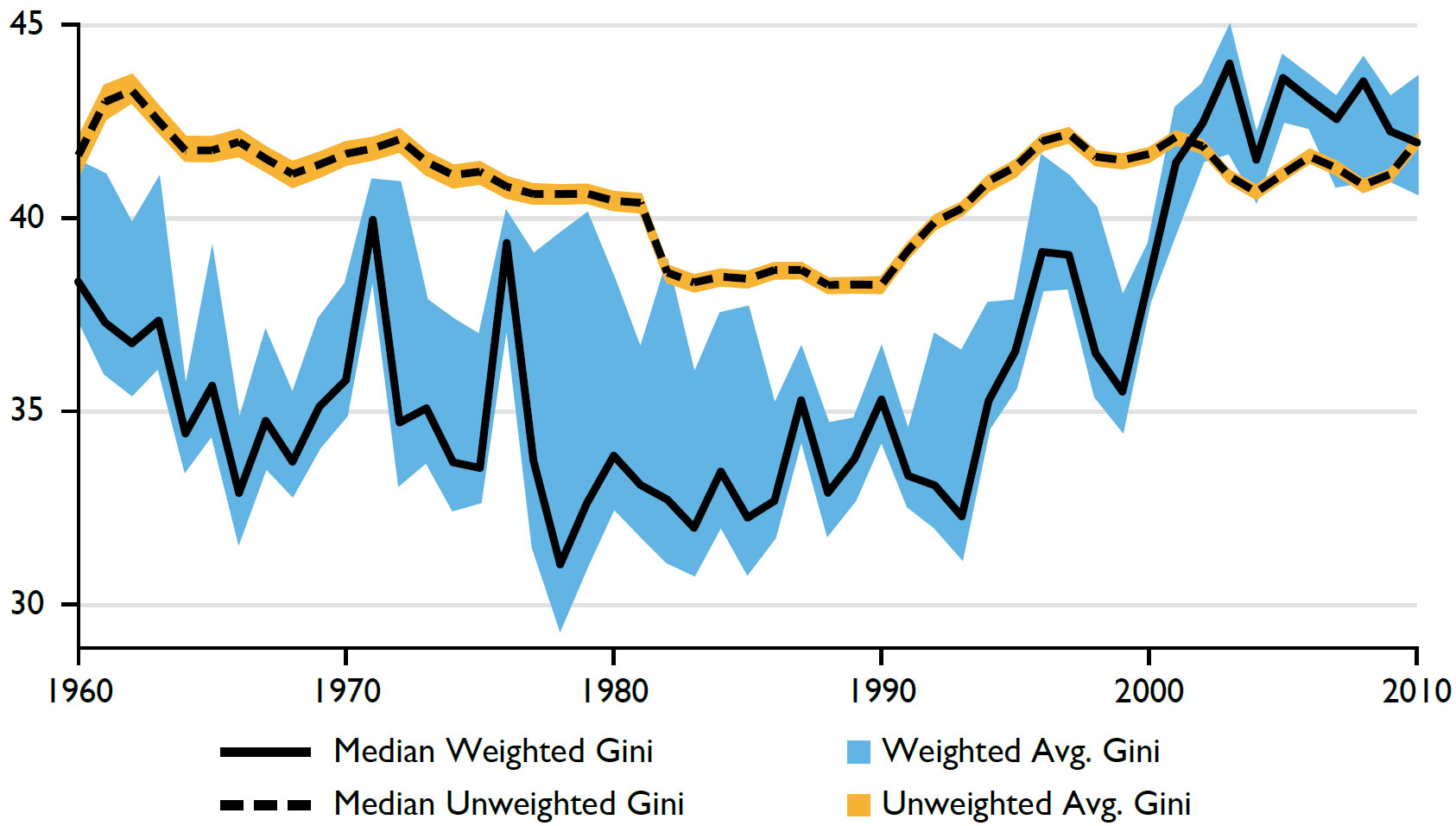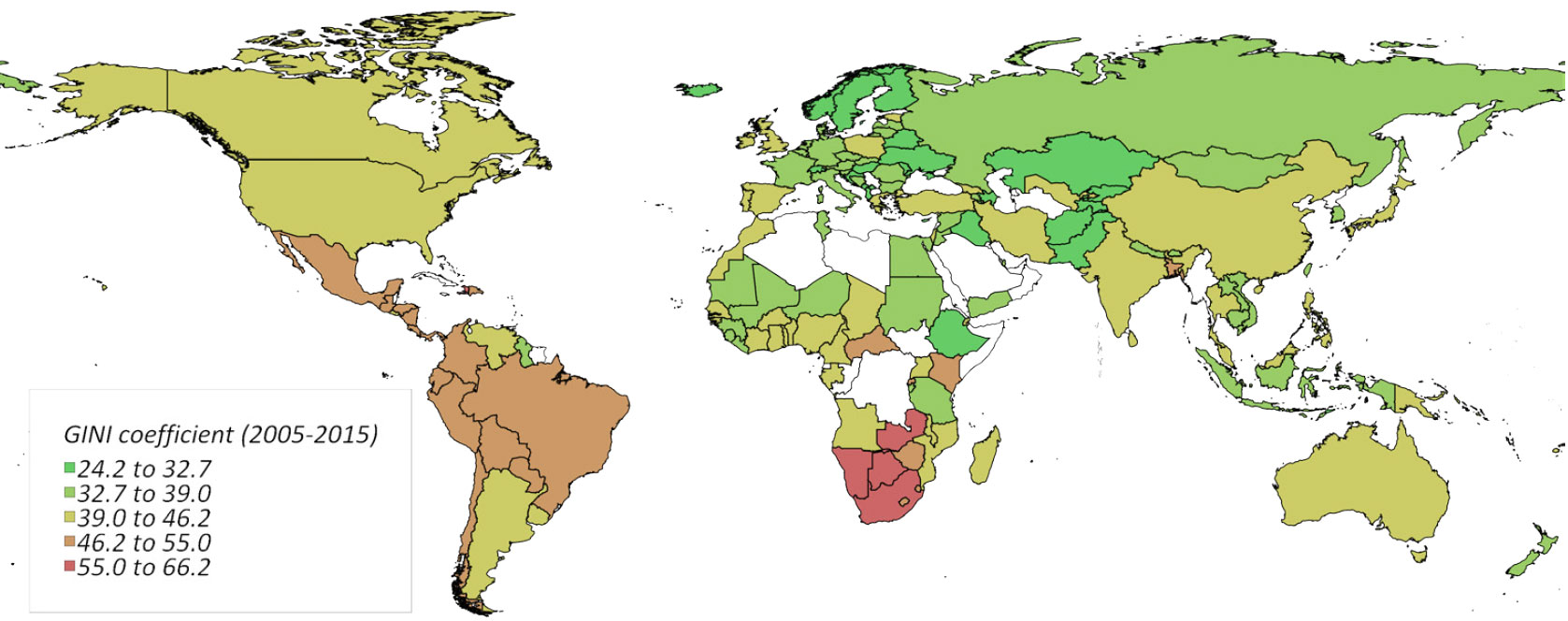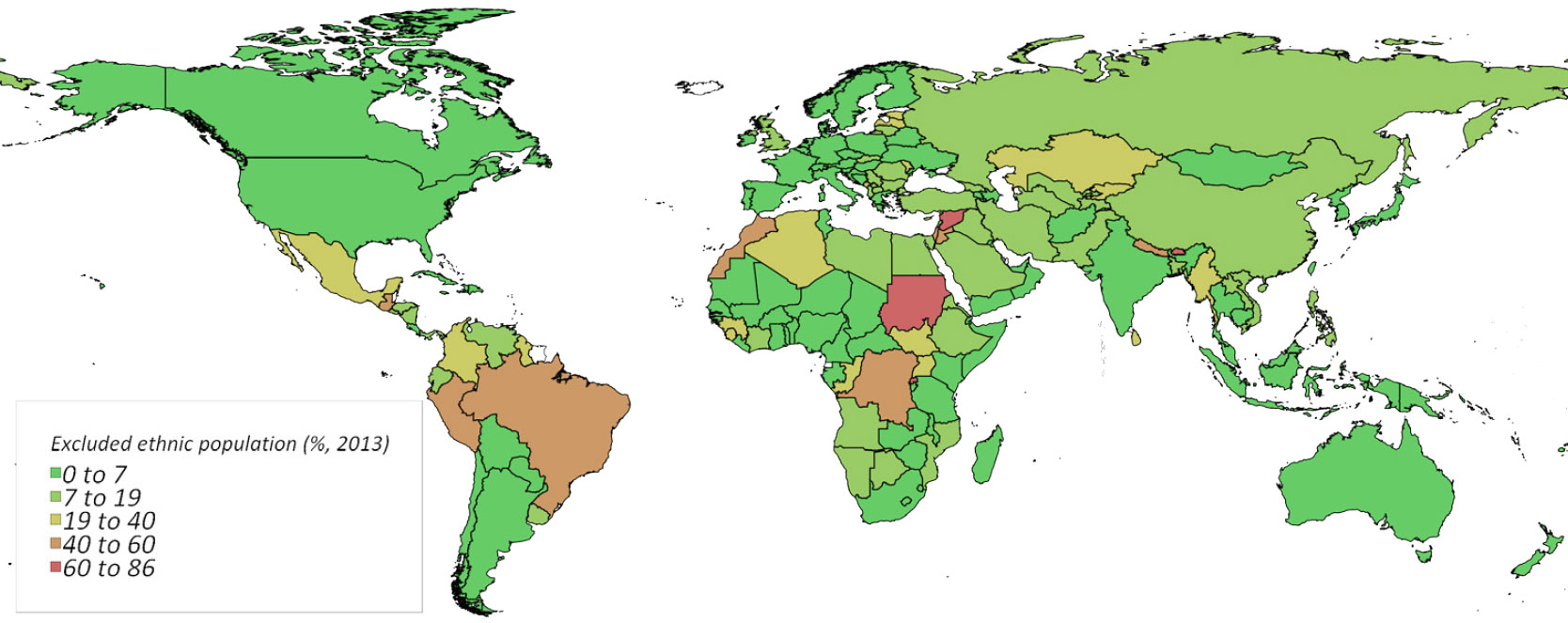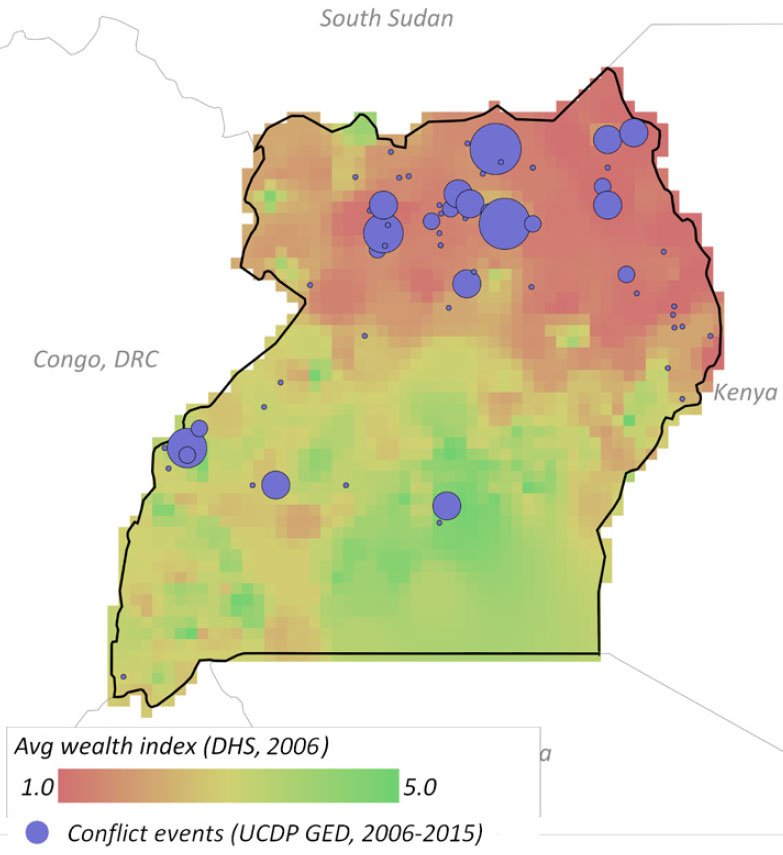The data analysts in this article confirm a common belief – i.e., the onset and recurrence of armed conflict is likely where high inter-group inequalities exist. Indeed, groups that have strong shared identities, a collective perception of ill treatment, and opportunities to take up arms are likely to use violence to rectify existing inequalities. In response, policy makers should take concrete measures to ensure the fair distribution of public goods and more.
Research shows that the onset and recurrence of armed conflict is likely where high inter-group inequalities exist. Groups that have strong shared identities, a collective perception of ill treatment, and opportunities to take up arms are likely to use violence to rectify existing inequalities. Policy makers can take concrete steps to reduce group-level inequalities through measures that share political and economic power between groups, ensure the fair distribution of public goods and services, and recognize cultural identities.
Brief Points
Inequalities can provoke and prolong conflict as well as its recurrence in fragile settings.
Strong group identities coupled with salient grievances can inspire violence.
Both objective and subjective inequalities are important predictors of conflict onset.
Effective policies need to address underlying sources of inequality.
Inequality and Conflict: The Debate
The political and social consequences of inequality have been a contentious topic of debate for centuries, ranging from the discourse of the ancient Greeks, to Karl Marx’s Communist Manifesto, to the more recent Capital in the Twenty-First Century by Thomas Piketty. This continued relevance is for good reason. Despite decreases in inequality between states, inequality (as measured by the Gini coefficient) has risen within states in recent years (see Figures 1 and 2). Indeed, inequality has come to be seen as so important that an entire Sustainable Development Goal (#10) has been devoted to the issue.
This policy brief reviews findings about the relationship between inequality and conflict. Conflict generally occurs in highly unequal societies, and rising levels of inequality bode ill for future conflict trends. As a result, this brief also provides policy recommendations aimed at reducing inequalities and thereby reducing the likelihood of violent conflict.

Figure 1: Trends in income inequality. Source: WIDER Income Inequality Database
Vertical Inequalities
The focus of most research into the relationship between conflict and inequality has been on vertical inequalities – that is, income or wealth inequalities between individuals or households. For example, the Gini coefficient was developed to measure this type of inequality, and has been used widely by scholars and practitioners.
Despite an abundance of research on this topic, we have yet to answer how or why vertical inequalities lead to conflict. The findings of the literature can be described as mixed at best, with some scholars finding evidence of a strong link and others failing to find a connection at all. These mixed results, along with insights about the importance of group dynamics in collective violence, prompted a new turn to examine the relationship between group-level (or “horizontal”) inequalities and conflict.

Figure 2: Vertical economic inequality in the world, average for period 2005-2015. Source: WIDER Income Inequality Database
From Vertical to Horizontal Inequalities
Horizontal inequalities are economic, social, and political inequalities between groups. Research on the relationship between horizontal inequalities and the onset of armed conflict is better able to predict the outbreak of conflict than that on the vertical inequality-conflict relationship.
Scholars argue that horizontal inequality is a better explanation for the outbreak of armed conflict because only identity markers other than class (such as ethnic, linguistic, religious, etc.) are strong enough to overcome the barriers to collective action and violence. Three main factors are required to turn horizontal inequality into conflict: identity, grievance, and opportunity.
Shared understanding (identity) of a group’s collective wellbeing (grievance) motivates the members of that group to engage in violence to either protect their already-existing advantages or to grant their group benefits (via opportunity). In other words, group identities ensure the cohesion of the group and bind members together around salient social, political, or economic issues in a common struggle for greater equality. For example, a minority religious group that is excluded from power by a larger majority group could use their shared identity as a “glue” to unite and engage in conflict, if the opportunity arises.
Conflict may represent the best outlet for expressing frustration about a social situation, especially when all other pathways to justice or access to resources seem blocked or limited. However, purely objective inequalities are often not enough to spur individuals and groups to commit violent acts.
Perceived Inequalities
Inequalities do not necessarily translate into violence. Often, groups fail to perceive that inequalities exist. It is when inequalities are perceived as unjust that groups are more likely to act. This perception is often referred to as grievance, and it represents a vital link in the chain linking inequality and violence. This makes intuitive sense; if groups do not know or realize that they are being treated unequally, it seems obvious that they would be much less motivated to act. An example of this can be drawn from a study in Indonesia with three equally resourcerich provinces with high objective inequality, in which only one province erupted into conflict: the province in which elites worked hard to transform grievances into urges for violence.
Additionally, objective and perceived inequalities are related, but they do not always overlap. Examples of cases with poor overlap include the Tonga ethnic group in Malawi and ethnic groups in Namibia. The Tonga are among the best-off groups in their country according to the objective horizontal inequality measure, but based on the perceived measure, they consider themselves worse off than other groups. At the other end of the spectrum is the Wambo ethnic group in Namibia. This group is among the relatively poorest groups in Namibia based on the actual measure of horizontal inequalities, but they consider themselves about as well off as other groups in the country.
From Inequality to Conflict
Still, it is not completely obvious that even strongly held perceptions of inequality can and do mobilize individuals to engage in violence. Evidence shows that objective and subjective inequalities result in protest, but bridging the gap to violence is trickier. Perceived grievances about inequalities are vital in determining whether objective horizontal inequalities lead to violence or not, and this leap often depends on the type of inequality experienced, as well as the combination of several factors, including perceptions.
Importantly, misperceptions can also play an important role, resulting in objectively advantaged groups mobilizing to commit violent acts to shore up their privileged position. Trigger events are often necessary to crystallize group anger and angst in the form of violent conflict, though very little research has been done into the forms that these events might take. Some initial research points to a few events, such as the discovery of natural resources and the subsequent unequal distribution of the benefits of those resources, which may serve as a spark to unite a group’s sense of collective grievance.

Figure 3: Share of population belonging to excluded ethnic groups (EPR). Source: GeoEPR Dataset
Another part of the mobilization process involves so-called political and ethnic entrepreneurs, who politicize and utilize existing inequalities to fulfill their own ends by legitimating the use of violence. Moreover, new elites can emerge to challenge established figures that do not confront perceived inequalities adequately. This can set off a process of ethnic outbidding, whereby the original leader reacts against challenges in leadership with an even more extreme proposal in order to sway support back, ultimately resulting in increasingly more extreme (and violent) promises and proposals to resolve grievances. The process of outbidding resulted in the weakening of moderate political leaders and parties in favor of more ethnically polarized groups in Northern Ireland, Cyprus, Mauritius, and even in the contemporary United States, to name but a few examples.
A long debate has pitted grievance against greed as two possible causes of conflict. More recent studies have taken a more nuanced approach, positing that these forces work in tandem to provide an environment ripe for conflict. That is, there needs to be not only the opportunity for conflict, but also a set of underlying salient issues and grievances and a set of existing social networks and resources in order for conflict to occur. This explains why horizontal inequalities are more closely linked to conflict than vertical inequalities: horizontal inequalities provide the fuel (perceived inequalities), the spark (opportunity to fight this perceived injustice), and the oxygen (sustained networks and collective group willpower to engage) for the fire (conflict).
Relevance of Inequalities
The topic of horizontal inequalities is highly relevant because of the vast numbers of excluded citizens around the world. Figure 3 shows the share of the population in each state belonging to a politically excluded ethnic group. A survey of the countries with the largest proportion of excluded citizens – such as Syria, Sudan, and the Democratic Republic of the Congo – illustrates the potential for conflict associated with exclusion.
A closer examination of Figure 4, showing Uganda, makes this pattern explicitly clear. Figure 4 represents the average wealth index (showing cumulative household living standards) in Uganda, with red areas representing greater inequality and green representing less inequality. The overlaid circles represent areas in which conflict has erupted since 2006, with larger circles representing more frequent violence. The connection between inequality and conflict is striking. Policymakers would be wise to heed these trends by implementing new policies to foster inclusion and thereby reducing the likelihood of violent conflict.
Policy Recommendations
A number of policies have been put in place in fragile states in order to prevent conflict from occuring at all, or to reduce the likelihood of it recurring. Yet there is a lack of systematic, robust evidence about the effects of the various types of policies on conflict outcomes. Successful implementation and adjustment of any inequality-conflict mitigation policies will require the collection of data that accurately and adequately measures not only the alleviation of objective inequalities, but also of perceived inequities. An intrinsic difficulty is the lack of data surrounding both sides of violent events – i.e. data about inequalities leading up to and after a conflict – which could help predict recurrence.

Figure 4: Wealth and conflict in Uganda (2006-2015). Source: DHS, UCDP GED
Our policy recommendations involve three distinct aspects of conflict: onset, recurrence, and peace agreements.
First, there is sufficient evidence to suggest that political institutional measures, territorial decentralization, educational policies, and cultural recognition can help to avert the onset of conflict.
Political power-sharing as well as territorial autonomy policies also seem to reduce the risk of conflict recurrence. Wealth sharing policies have not been proven to be effective. Post-conflict educational provision has a positive impact on peace duration, but post-conflict economic policies have a mixed record in their impact on peace duration.
Finally, peace agreements will more adequately address the grievances driving conflict if they incorporate power- and wealth-sharing provisions as well as measures recognizing the importance of education, civil society, and gender. A potential area of improvement for inclusive peace agreements would be to provide specific provisions for important economic issues like systematic inequalities in employment and land reform, which are often key motivating grievances for rebellion. Peace agreements have a higher likelihood of success when they involve and include non-elite groups – particularly those who have experienced grievances over time. Agreements made solely by elites are unlikely to address these underlying problems, which may lead to a recurrence of violence. As a result, good policies will build social cohesion and a reduction of harmful inter-group inequalities, mitigating this risk.
Examples of Policy Implementation
Successful inequality-conflict mitigation policy measures work by incorporating inclusion, executive constraint, and partition of groups, each of which provide these warring groups with superior incentives and rewards for peaceful cooperation than for violent competition.
For example, multi-ethnic policing in Kosovo has been a critical factor in successful community- level policing in post-conflict Kosovo, and the police are far more ethnically integrated than other segments of society. These policies were not put in place in the Democratic Republic of Congo, with the result that local ethnic entrepreneurs capitalized on the failure to create ethnically balanced security forces in 2009, leading to violent inter- and intra-community tensions.
Ghana is another interesting case study. Unlike its neighbors, Côte d’Ivoire and Nigeria, Ghana has never experienced armed conflict. Perhaps the single strongest reason for Ghana’s peacefulness lies in the symbolic impact of how state leaders, starting immediately after independence, promoted a strong national identity, actively supported teaching all the country’s languages, and emphasized the state as culturally inclusive and neutral by stressing the value of each ethnic group.
Political institutional measures were also important in preventing the formation of strong horizontal inequalities in Ghana: the country’s legal framework requires political parties to have a national character, and parties have formally agreed to refrain from using ethnicity in electoral campaigning. Furthermore, the state has worked to ensure balanced regional representation in the executive (striving to include the economically disadvantaged northern region in particular), and has tried to overcome regional development gaps through redistribution. Though it is yet unclear the extent to which Ghana’s successes can be generalized, it nevertheless represents a clear example of successful inclusionary policies that mitigate the kinds of inequality that lead to violence.
Further Research and Conclusions
Given the increasing prevalence of horizontal inequalities over time, and the very limited evidence base regarding the effectiveness of policies adopted to address horizontal inequalities on conflict onset and recurrence, more rigorous analysis of policy outcomes is needed. Further research and policy work in this area should aim to improve our understanding of::the sequencing of reforms, how and why context shapes reform implementation, interaction and conditional effects, the ways in which policy reforms themselves can trigger conflict, and how policy reforms may shape perceptions of inequalities. Critically, the fundamental question as to under which conditions policy measures can address the root causes of poverty and of conflict remains. Only when we confront these issues can we adequately address the underlying factors that transform inequality into conflict.
About the Authors
Karim Bahgat is Research Assistant at PRIO, Gray Barrett is a Research Intern at PRIO, Kendra Dupuy is a Senior Researcher at PRIO/CMI, Scott Gates is Research Professor at PRIO and Professor at UiO, Solveig Hillesund was Senior Researcher at PRIO, Håvard Mokleiv Nygård and Siri Aas Rustad are Senior Researchers at PRIO, Håvard Strand is Senior Researcher at PRIO and UiO, Henrik Urdal is Research Professor at PRIO, and Gudrun Østby is Senior Researcher at PRIO.
No comments:
Post a Comment